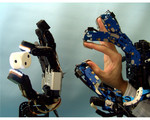May 22, 2007
Haptic Telexistence

at SIGGRAPH 2007
Haptic Telexistence (SIGGRAPH 2007) provides highly realistic haptic interaction among humans and objects located in remote places. Human interaction will be dramatically improved by this concept, which perceives us as the properties of an object.
Enhanced Life: With conventional systems, we can only perceive the stiffness of an object. But with Haptic Telexistence, we can also perceive the exact shape of an object, and more natural and dexterous object manipulations become possible. This simplifies complex tasks such as telesurgery and 3D modeling.
Because this system can present properties such as texture and temperature, it will support dramatic improvements in human life. For example, not only will we be able to shake hands with people at remote locations but we will also be able to feel the warmth of their hands. While shopping on the web, we will be able to check the texture of an article before purchase.
Goals: Our ultimate goal is to present all the haptic sensations through a master-slave system. Using current telepresence systems, we can interact with humans or objects even if they are located in remote places or in virtual environments. We can watch, listen, touch, and move objects. However, the properties of an object are not present in these systems, and that reduces realism and interactivity. Haptic Telexistence aims to provide highly realistic haptic interaction among human and objects in remote places.
Innovations: The system consists of four innovative devices: a dexterous slave hand, q finger-shaped haptic sensor for the slave hand, an encounter-type master hand, and an electro-tactile display. Each of these devices has more advantages than the corresponding conventional ones. In addition, integrating them to realize Haptic Telexistence is also a technical innovation.
Vision: Because haptic and robotic technologies continue to improve rapidly, we believe that this technology will be fully realized with 10 years.
Contact
Katsunari Sato
The University of Tokyo
Katsunari_Sato (at) ipc.i.u-tokyo.ac.jp
Contributors
Kouta Minamizawa
Naoki Kawakami
Susumu Tachi
The University of Tokyo
Posted by jo at May 22, 2007 09:01 AM
